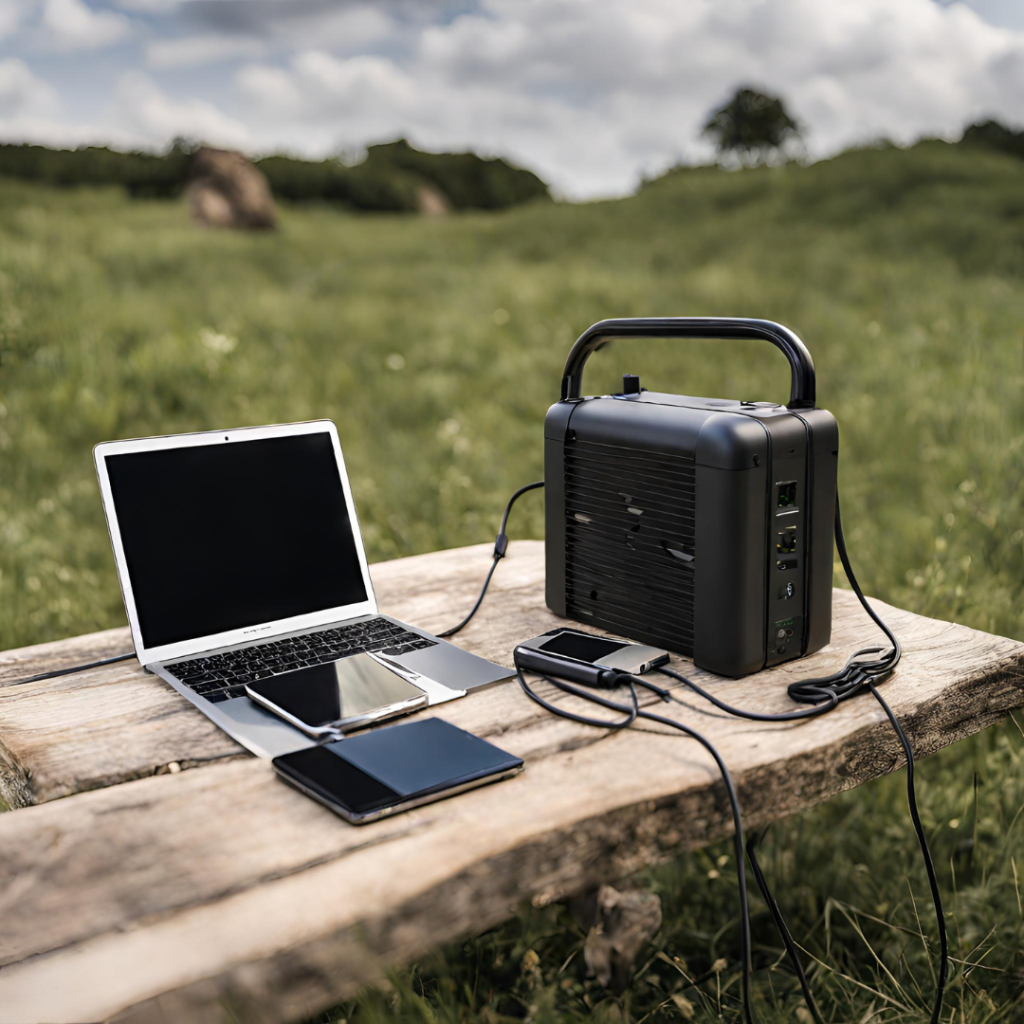Understanding Wattage for Portable Power Stations

Understanding wattage is critical when it comes to powering devices using a portable power station. The wattage of a device determines the amount of electricity it consumes and how much power it requires to function. When using a portable power station, understanding wattage for portable power stations and the devices you intend to power is essential to ensure that you do not damage the devices or the power station. I use these types of calculations when I consult with homeowners on power backup options.
Portable power stations come in various wattages, ranging from as low as 150 watts to as high as 3000 watts. The wattage of the device will depend on the battery capacity and the number and type of output ports. The most common wattage ranges for portable power stations are 200-500 watts, 500-1000 watts, and 1000-2000 watts. It is important to note that the total wattage of all the devices you want to operate at the same time cannot exceed the maximum AC output of the portable power station.
Understanding wattage is critical when using a portable power station. It is essential to ensure that you do not damage the devices or the power station. By knowing the wattage of the devices you intend to power, you can select the appropriate portable power station that can supply the required wattage.
Understanding Wattage and Its Implication
Wattage Basics
Wattage is a measure of the amount of power required by an electronic device or appliance to function. It is the product of voltage and current (in amps) and is measured in watts (W). Wattage is an essential factor to consider when choosing a portable power station for your devices.
Device and Appliance Wattage
Every device or appliance has a specific wattage rating. Smaller devices such as phones, tablets, and laptops require less wattage, whereas larger appliances such as air conditioners and power tools require more wattage. It is essential to know the wattage of your devices and appliances to ensure that they can be powered by your portable power station.
Calculating Wattage for Devices
Calculating the wattage for your device is easy. You need to know the voltage and current (in amps) required by the device. You can then multiply the voltage and current to get the wattage. For example, if your device requires 12 volts and 2 amps, the wattage required would be 24 watts (12 volts x 2 amps = 24 watts).
Impact of Wattage on Performance
The wattage of your device or appliance has a direct impact on its performance. If your device requires more wattage than your portable power station can provide, it will not function correctly. On the other hand, if your device requires less wattage than your portable power station can provide, it will function correctly, but your portable power station's battery will last longer.
It is essential to consider the wattage of your devices and appliances when choosing a portable power station. Ensure that the portable power station you choose can provide enough wattage to power all your devices and appliances.
Portable Power Stations and Their Wattage
Understanding Portable Power Stations
Portable power stations are a great way to keep your devices charged when you're on the go. They are essentially battery packs that can be charged via a wall outlet, a car charger, or a solar panel, and can then be used to charge your devices. They come in various sizes and capacities, and the wattage of the device will depend on the battery capacity and the number and type of output ports.
Some of the most popular portable power stations on the market today include Jackery, Bluetti, and Anker. These brands offer a range of different wattages and capacities, so it's important to choose one that meets your specific needs.
Wattage for Different Portable Power Stations
The wattage of a portable power station determines the type of devices it can support. For example, a 200-watt portable power station like the Jackery 240 Portable Power Station can power small devices like smartphones, tablets, and laptops. However, models with a larger power supply, such as the 1,000-watt Jackery Portable Power Station, can power larger appliances like refrigerators, TVs, and power tools.
The most common wattage ranges for portable power stations are 200-500 watts, 500-1000 watts, and 1000-2000 watts. It's important to choose a wattage that is appropriate for your needs. If you're just looking to charge small devices, a lower wattage may be sufficient. However, if you need to power larger appliances, you'll need a higher wattage.
Charging Options and Time
Portable power stations can be charged using a variety of methods. The most common are via a wall outlet, a car charger, or a solar panel. Charging times will vary depending on the capacity of the battery and the charging method used. For example, charging a 500-watt portable power station via a wall outlet may take around 6-7 hours, while charging the same device using a solar panel may take up to 12 hours.
It's also important to note that some portable power stations offer fast charging capabilities, which can significantly reduce charging times. Additionally, some models offer wireless charging and USB-C ports, which can provide even more flexibility when it comes to charging your devices.
Understanding the wattage of a portable power station is crucial when it comes to choosing the right device for your needs. By considering factors such as battery capacity, output ports, and charging options, you can find a portable power station that will keep your devices charged no matter where you are.
Using Portable Power Stations
Portable power stations are a great way to have emergency backup power when there's a power outage or when you're camping or traveling. They come in various wattages, ranging from as low as 150 watts to as high as 3000 watts. The wattage of the device will depend on the battery capacity and the number and type of output ports. The most common wattage ranges for portable power stations are 200-500 watts, 500-1000 watts, and 1000-2000 watts.
In Different Scenarios
Portable power stations can come in handy in different scenarios. For example, if you're camping or traveling, you can use them to power your phone, laptop, tablet, or other electronics. If you're experiencing a power outage or blackout, you can use them to power your refrigerator, fridge, or space heater. If you're in an emergency situation, you can use them to power your phone or other communication devices.
With Different Devices
When using a portable power station, it's important to consider the wattage you need to power your devices. For example, if you need to power a laptop and a smartphone, you may only need a portable power station with a few hundred watts of power. On the other hand, if you need to power a refrigerator or space heater, you'll need a portable power station with a higher wattage.
It's also important to consider the type of output ports the portable power station has. Some devices may require a USB port, while others may require an AC outlet. Make sure the portable power station you choose has the appropriate output ports for your devices.
Portable power stations can be a great investment for those who need emergency backup power or for those who enjoy outdoor activities. When choosing a portable power station, make sure to consider the wattage you need and the type of output ports your devices require.
Cost and Eco-Friendly Aspects
Cost Factors
When it comes to portable power stations, the cost can vary widely depending on factors such as wattage, battery capacity, and number and type of output ports. Generally, the higher the wattage and battery capacity, the more expensive the device will be. However, it's important to keep in mind that a higher upfront cost can lead to long-term savings, especially if you plan to use the device frequently or in emergency situations.
Another cost factor to consider is compatibility. Make sure that the portable power station you choose is compatible with the devices you plan to power. Some devices may require a higher running wattage than others, so it's important to choose a device with enough power to meet your needs.
Eco-Friendly Aspects
Portable power stations can be a more eco-friendly alternative to gas generators, as they don't produce harmful emissions and can be powered by renewable energy sources such as solar panels. Additionally, many portable power stations use lithium-ion batteries, which are rechargeable and have a longer lifespan than traditional lead-acid batteries.
When choosing a portable power station, consider the device's eco-friendliness. Look for devices that are designed to be energy-efficient and have low standby power consumption. Some devices may also come with eco-friendly features such as automatic shut-off when not in use.
Overall, when considering cost and eco-friendliness, it's important to weigh the long-term benefits of a higher upfront cost against the potential savings and environmental impact. By choosing a portable power station that meets your needs and is designed with eco-friendliness in mind, you can power your devices while minimizing your impact on the environment.
Frequently Asked Questions
What is the difference between watts and amps?
Watts and amps are both units of measurement used to describe the flow of electrical power. Watts are a measure of the total power consumed by an electrical device, while amps are a measure of the current flowing through the device. In other words, watts describe the overall energy consumption of a device, while amps describe the rate at which that energy is being consumed.
What does starting watts mean on a generator?
Starting watts, also known as surge watts, are the amount of power a generator can produce for a short period of time to start up appliances or devices with high initial power requirements. This is typically higher than the running watts, which is the amount of power the generator can produce continuously.
What does peak watts mean on a generator?
Peak watts are the maximum amount of power a generator can produce for short periods of time. This is typically higher than the running watts and is used to power devices with high initial power requirements.
How much power should a portable power station have?
The amount of power a portable power station should have depends on the devices you plan to power with it. Generally, a 200-500 watt portable power station is sufficient for charging small devices like phones and tablets, while a 1000-2000 watt portable power station can power larger appliances like refrigerators or power tools.
What can a 200w portable power station run?
A 200w portable power station can run small devices like phones, tablets, laptops, and small LED lights. It is not powerful enough to run larger appliances like refrigerators or power tools.
Can a 200w power station run a TV?
A 200w power station may be able to run a small TV, but it depends on the TV's power consumption. It is recommended to check the TV's power requirements and compare it to the power output of the power station before attempting to use it.
Articles related to Assessing Power Requirements:
Medical Device Power
Appliance Power Consumption
Solar Power Station Sizing
Emergency Power Planning Guide
Outdoor Event Power
Digital Nomad Power
Wattage for Devices
Emergency Preparedness Power Planning
Camping Equipment Power
RV Power Requirements
